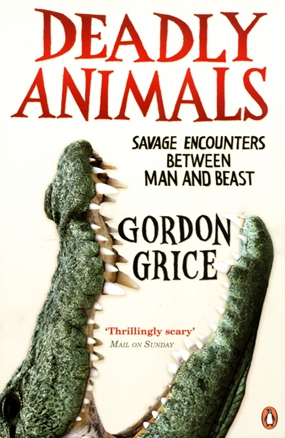One of the most eye catching covers, Deadly Animals by Gordon Grice (ISBN 978-0-241-95129-3, Penguin, 2012) just had to be taken home to read all about “savage encounters between man and beast”.
Author Grice has collected an enormous data bank and comes up with some very interesting statistics. For example, the most dangerous large animal in the US turns out to be the dog, with 4.7 million dog bites inflicted on humans in one year. In the UK 5,000 posties are nipped each year.

Grice explains that the domestic dog is merely part of the wolf family and belong in a dominance hierarchy. Seeing themselves as fairly lowly members of the human clan, a dog will try to dominate weaker humans, especially children, and goes on to describe the deaths and injuries inflicted upon children by the family pet.
The narrative tends to be somewhat ghoulish, with for example the tale of a young girl kept in after school in Belarus who then had to go home alone. When she was late, the father went looking for her. “On a stretch of snow darkened by blood and marked by the prints of wolves, he discovered her severed head. He later killed the teacher.”
Bears are dealt with in detail and the most dangerous to us humans is the sloth bear, racking up 735 attacks on humans with 48 fatalities over a five year period in Central India.
The big cats, lions, tigers, leopards, pumas all have a record of killing humans (tigers having killed 12,599 in the last century), and the job of a lion tamer is definitely hazardous. Wild animals are never domesticated, but will seize the upper hand one day.
Aquatic creatures get their mention, with sharks certainly near the top of the bill, but other swimmers such as the orca (killer whale) are much more dangerous. And do not forget the box jellyfish and its fatal stings. Interestingly, one of Pattaya’s prominent business people was attacked by a dolphin, requiring operation for a ruptured liver.
Many other chapters follow, with reptiles and birds, arthropods and worms, other mammals (including elephants, which anyone living in Thailand knows are dangerous) right down to rodents and bats.
At B. 430 it is not an expensive book, but I felt the encounters were more between beast and man, than between man and beast. I felt that Grice goes into gratuitous detailing of the deaths of some unfortunates and how the muscle was ripped from the bone, or skulls crushed and the eyes popping out. Really, all I needed to know was that the person was killed.
Once again, I also wish to complain about the paper stock used by Penguin. After a couple of reads, the letters will have worn off the pages, and the reproduction of the photographs is dreadful, with smudgy grey on grey. The interest provided by the text then gets diluted by the poor reproduction. Penguin has been publishing since 1935, and I expect better after 77 years of being in the game. I realize that times are tough, but please do not lower your standards, Penguin!




